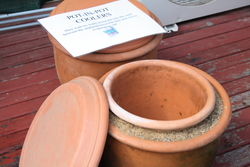When I was thinking of things to have just in case of an emergency during hot weather I thought about Mama's cool house. Well, here in the city, it's not likely that I'll ever have a stream running across my back yard unless a water main breaks. So I started thinking of an alternative for keeping foods cold and safe to eat even in the summer.
I hear about black outs, or maybe it's brown outs, where electricity goes out because of overloads on the system. So many new items are added in homes everyday which require electricity that a loss of power is a real possibility. Especially in the summer when the demand is high to keep air conditioners running. Our electric system is very old and is not designed for people to add and add and add more demands on it. Homes that used to not have even one computer or tv now have several and so forth. I'm doing what I can to use less while I can.
I kept thinking what would I do about my refrigerated foods if the power went out again for several days and it was 100 degrees outside? I've lost all my food one time too many. I'm skittish about it even though I use my freezer a lot. I kept thinking what if I had medications I needed to keep cold? What would I do about having cold water to drink? I was also remembering how I kept my daughter cool while sleeping during the summers when my utilities got cut off. Then a tiny spark of a thought came to me. Something I had read about in a magazine years ago. I believe the magazine was Mother Earth News or something similar? I can't remember exactly. Anyway, I did some research and came up with a couple of ideas.
Have you ever heard of a coolgardie safe? If you haven't, this is what one looks like. It works with evaporation of water to keep foods safe to eat in hot weather. Water is kept in the top. Burlap covers it with the ends of the burlap in the water at the top. The water is wicked up by the burlap. Eventually the whole burlap is wet. The water starts to evaporate from the heat and air movement. The evaporation draws the heat out from the inside of the safe so the inside stays cool. There is a pan to hold water at the bottom too but this is to keep ants from getting to the food. I guess those ants don't build ant bridges? The coolguardie safe was invented in Australia in the 1800s.

Ok, here's a modern version of the coolguardie safe. This is called a pot in pot cooler. I believe these are being given to people in Africa but I'm not sure. It also works with evaporation. Two large non-glazed pots are used. There is sand between the two pots. The sand part is filled with water to soak the sand. The water from the sand wicks into the outside pot where it evaporates. The evaporation draws the heat from inside the pot keeping the food inside cool. The sand also acts as an insulation for the inside pot. The top is to help keep it cool inside too.

Can you guess what's been added onto my wish list?
Update November 6, 2010: I completely forgot to put a link to the sites where I found these photos. I can't remember exactly where I found the photo of the 1800s coolguardie safe. If I remember right it was a museum site or antique site or something like that. I'll post that link if I can find it again.
The pot n pot photo came from a really interesting site called Under the choko tree. A site written by a couple in Australia who have tried to live simply for many years and now they are writing about it. Linda and Nev Sweeney. If you get a chance you should go visit their site. In my wanderings around the internet I find some very intersting people living in Australia. From quilters to homesteaders and everything in between.
No comments:
Post a Comment